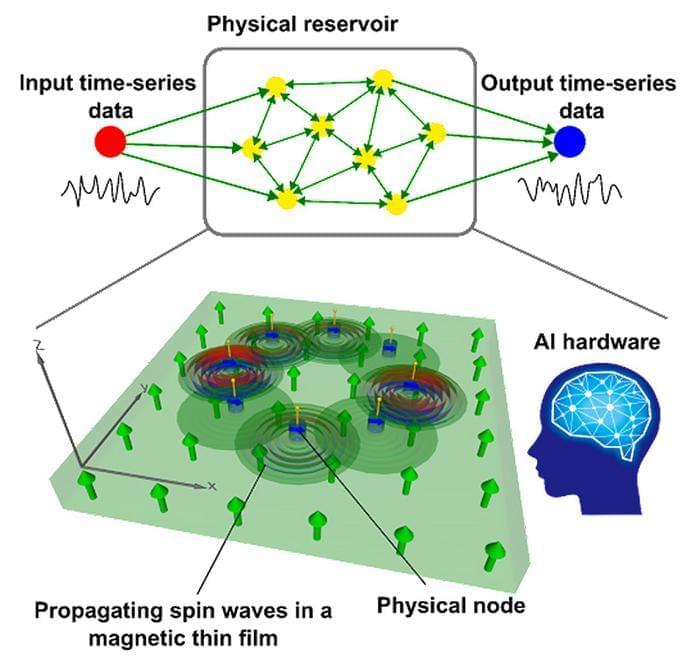The show on Tuesday night was an abstract light show partially designed with AI.
Get the latest international news and world events from around the world.

Giant ‘sand battery’ holds a week’s heat for a whole town
A new industrial-scale ‘sand battery’ has been announced for Finland, which packs 1 MW of power and a capacity of up to 100 MWh of thermal energy for use during those cold polar winters. The new battery will be about 10 times bigger than a pilot plant that’s been running since 2022.
The sand battery, developed by Polar Night Energy, is a clever concept. Basically, it’s a big steel silo of sand (or a similar solid material) that’s warmed up through a heat exchanger buried in the center, using excess electricity from the grid – say, that generated during a spike from renewable sources, when it’s cheap.
That energy can then be stored for months at a time, with reportedly very little loss, before being extracted as heat on demand. This could theoretically be converted back into electricity, although with some energy loss. But Polar Night says that the most efficient method is to just use the heat itself.

OpenAI CEO Sam Altman seeks as much as $7 trillion for new AI chip project: Report
OpenAI CEO Sam Altman is seeking trillions of dollars in investments to overhaul the global semiconductor industry, The Wall Street Journal reported.
Altman has long talked of the supply-and-demand problem with AI chips — many AI giants want them, but there aren’t enough to go around — and that it limits OpenAI’s growth. He’s considering a project that would increase global chip-building capacity, according to a Thursday evening report in The Wall Street Journal, and is reportedly in talks with different investors, including the government of the United Arab Emirates.
Altman could need to raise between $5 trillion and $7 trillion for the endeavor, The Wall Street Journal reported, citing one source. CNBC could not confirm the number. OpenAI did not respond to a request for comment.

Astronomers Discover Heavy Elements after Bright Gamma-Ray Burst from Neutron Star Merger
Breakthrough discovery puts astronomers one step closer to solving the mystery of the origin of elements that are heavier than iron. An international team of astronomers — including Clemson University astrophysicist Dieter Hartmann — obtained observational evidence for the creation of rare heavy elements in the aftermath of a cataclysmic explosion triggered by the merger of two neutron stars.
The massive explosion unleashed a gamma-ray burst, GRB230307A, the second brightest in 50 years of observations and about 1,000 times brighter than a typical gamma-ray burst. GRB230307A was first detected by NASA’s Fermi Gamma-Ray Space Telescope on March 7, 2023.
Using multiple space-and ground-based telescopes, including NASA’s James Webb Space Telescope, the largest and most powerful telescope ever launched into space, scientists were able to pinpoint the source of the gamma-ray burst in the sky and track how its brightness changed.

First Metamaterial developed to Enable Real-time Shape and Property Control
Engineers have unveiled an encodable multifunctional material that can dynamically tune its shape and mechanical properties in real time. Inspired by the remarkable adaptability observed in biological organisms like the octopus, a breakthrough has been achieved in soft machines. A research team, led by Professor Jiyun Kim in the Department of Materials Science and Engineering at UNIST has successfully developed an encodable multifunctional material that can dynamically tune its shape and mechanical properties in real-time. This groundbreaking metamaterial surpasses the limitations of existing materials, opening up new possibilities for applications in robotics and other fields requiring adaptability.
Current soft machines lack the level of adaptability demonstrated by their biological counterparts, primarily due to limited real-time tunability and restricted reprogrammable space of properties and functionalities.
In order to bridge this gap, the research team introduced a novel approach utilizing graphical stiffness patterns.

Novel Sequenced Chemotherapy Regimen for Metastatic Pancreatic Cancer
A was assessed in a recent phase 2 trial.
The optimal first-line chemotherapy for advanced pancreatic cancer, validated in phase 3 trials, is the triplet combination of infusional 5-FU, oxaliplatin, and either irinotecan or nanoliposome-encapsulated irinotecan (FOLFIRINOX or NALIRIFOX). Now, in an industry-supported, randomized, phase 2 trial involving patients with metastatic pancreatic cancer, investigators compared the combination of gemcitabine and nab-paclitaxel to a novel sequenced regimen of gemcitabine and nab-paclitaxel followed by mFOLFOX-6 on a 6-week cycle.
Of 157 patients, the median age was 66, 94% had metastatic disease, only 18% had undergone prior surgery, and 4% had received prior chemotherapy. The primary endpoint of 12-month overall survival (OS) was higher with the sequenced regimen compared with gemcitabine/nab-paclitaxel alone (55.3% vs. 35.4%, P =0.02); median OS was also higher (13.2 vs. 9.7 months; hazard ratio, 0.68). Median progression-free survival was higher with the sequenced regimen (7.0 vs 5.2 months; HR, 0.52) as was the response rate (39.7% vs. 20.3%). Adverse events and rates of grade 3/4 neurologic toxicity were similar between the two treatment arms.
This small phase 2 trial indicates potential superiority for the sequencing of mFOLFOX6 with gemcitabine/nab-paclitaxel compared with gemcitabine/nab-paclitaxel alone. However, this sequencing regimen offers no clear advantage over the two approved triplet regimens, FOLFIRINOX and NALIRIFOX, and any statement about superiority compared with standard triplet therapy would require proof in a phase 3 trial.

Surgeons Use Apple VR Headset During Spinal Operation
A surgery team in the UK successfully utilized the recently-released Apple Vision Pro to assist spinal surgery — a fascinating use case for the augmented reality (AR) headsets that goes far beyond movie-watching, productivity-hacking, or distracted driving.
As Business Insider reports, the expensive “spatial computing” device was used to execute two microspinal procedures at London’s Cromwell Hospital. To be clear, it wasn’t the surgeons themselves who were wearing bunky AR headsets. The device was instead donned by an assisting surgical scrub nurse, who according to a press release used headset-integrated software called eXeX to access things like “surgical setup and the procedural guides from within the sterile field of the operating theatre,” in addition to any needed data or surgical visualizations.
So, in short: coupled with the eXeX software, the headset offered the folks in the operating room hands-free access to documents and other information related to the procedure and its workflow. Pretty cool!

Giant leap towards neuromorphic devices: High-performance spin-wave
A group of Tohoku University researchers has developed a theoretical model for a high-performance spin wave reservoir computing (RC) that utilizes spintronics technology. The breakthrough moves scientists closer to realizing energy-efficient, nanoscale computing with unparalleled computational power.
Credit: Springer Nature Limited


Deciphering the Dark: The Accelerating Universe and the Quest for Dark Energy
Dark energy’s role in propelling the universe’s accelerated expansion presents a pivotal challenge in astrophysics, driving ongoing research and space missions dedicated to uncovering the nature of this mysterious force.
Some 13.8 billion years ago, the universe began with a rapid expansion we call the Big Bang. After this initial expansion, which lasted a fraction of a second, gravity started to slow the universe down. But the cosmos wouldn’t stay this way. Nine billion years after the universe began, its expansion started to speed up, driven by an unknown force that scientists have named dark energy.
But what exactly is dark energy?